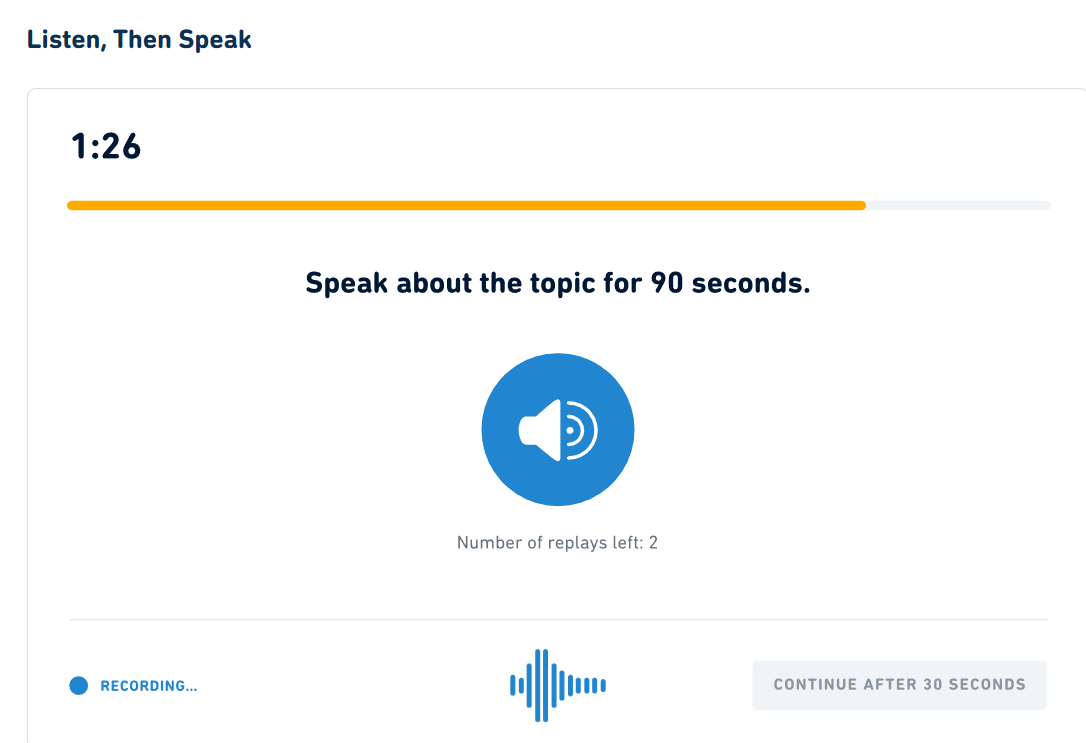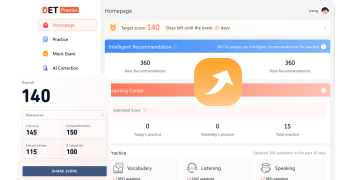Duolingo English Test Tipo de Pregunta Intro 13:"Escucha, Luego Habla"
En el Duolingo English Test de 2024, la sección "Listen, Then Speak" requiere que los examinados respondan a los indicaciones de audio en un máximo de 90 segundos. Esta publicación del blog ofrece una visión general completa de los tipos de preguntas que aparecen en "Listen, Then Speak" junto con estrategias efectivas para responderlas.
Comprender el tipo de pregunta "Listen, Then Speak"
La sección "Listen, Then Speak" es un tipo de pregunta en el Duolingo English Test (DET) destinado a evaluar las habilidades de comprensión auditiva y expresión oral del examinado. En esta sección, los examinados primero escuchan una indicación de audio, que puede ser una pregunta, declaración o descripción. Después de la indicación, se les da un breve período para preparar su respuesta antes de entregar su respuesta oral en un máximo de 90 segundos. Este tipo de pregunta se incluye dos veces en cada sesión de prueba, requiriendo un tiempo total de aproximadamente 3 minutos.
Tenga en cuenta que tiene un total de tres oportunidades para escuchar la grabación antes de que comience la grabación oficial.

Estrategias para responder
Escuchar y responder a las indicaciones:
En el Duolingo English Test, te enfrentarás a tareas que requieren que escuches una indicación y respondas verbalmente. Estas indicaciones pueden variar; podrían ser preguntas directas, como "What do you think about...?" o declaraciones como "Describe a memorable childhood experience." Se te permite escuchar la indicación hasta tres veces en un lapso de 20 segundos. Esta escucha repetida es esencial, ya que te ayuda a capturar todos los detalles necesarios. Una vez transcurridos los 20 segundos, debes comenzar a hablar, así que es importante estar preparado para expresar tus pensamientos claramente.
Maximiza tu escucha:
Aprovecha siempre la oportunidad de escuchar la indicación tres veces. Incluso si te sientes seguro después de la primera o segunda escucha, el intento final te ayudará a reforzar tu comprensión y retención de los detalles. Esta estrategia es especialmente beneficiosa para indicaciones más largas que contienen múltiples elementos.
Asegúrate de la relevancia de la tarea:
Tu respuesta debe alinearse estrechamente con el contenido de la indicación. Enfocarse en la relevancia es esencial para lograr una puntuación alta. Antes de comenzar a hablar, resume mentalmente la indicación para asegurarte de que tu respuesta se mantenga en el camino y responda completamente a la pregunta.
Mejora tu vocabulario y fluidez:
Usa una variedad de vocabulario y estructuras gramaticales para enriquecer tu respuesta oral. Incorpora frases de enlace para crear un flujo más suave en tu discurso. Revisar recursos que proporcionen ejemplos de frases de enlace efectivas puede elevar la calidad de tus respuestas y hacer que tu habla suene más natural.
Apunta a respuestas más largas:
Aunque el tiempo mínimo de habla es de 30 segundos, esfuérzate por elaborar tus puntos durante al menos 60 segundos. Esto no solo demuestra tu dominio del idioma, sino que también impacta positivamente en tu puntaje de fluidez. Practica expandir tus respuestas para desarrollar esta habilidad.
Practica regularmente:
Dadas las dificultades únicas de este tipo de pregunta, es crucial participar en una práctica constante. Aunque la prueba de práctica oficial carece de este formato específico, busca otros recursos o plataformas que permitan una práctica ilimitada en varios tipos de preguntas, incluidas tareas de escucha y habla. Esta práctica regular aumentará tu confianza y mejorará tu rendimiento.
Aunque la sección "Listen, Then Speak" es una de las partes más desafiantes del Duolingo English Test, la práctica constante y efectiva puede mejorar significativamente tu confianza y tus puntuaciones. Aquí tienes algunos excelentes recursos para practicar; ¡haz clic en el enlace de abajo para comenzar tu entrenamiento ahora!
Empieza a practicar con Official DET
Comienza el examen mock con prácticas DET






